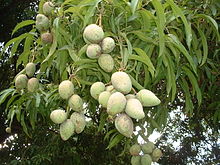Haribhanga (mango)
This article has multiple issues. Please help improve it or discuss these issues on the talk page. (Learn how and when to remove these messages)
|
| Mango 'Harivanga' | |
|---|---|
 Unripe mangoes on a mango tree | |
| Genus | Mangifera |
| Cultivar | 'Harivanga' |
| Origin | Bangladesh |
Harivanga, also known as Haaribhanga, is a type of mango produced in the northwest part of Bangladesh, especially in Rangpur district. Cultivation of the Harivanga mango has recently gained popularity among the farmers of northern districts.[1]
History
Harivanga was introduced around 2003 by Abdus Salam Sarkar, a retired government official, at Podaganj village under Mithapukur upazila of the Rangpur district. In 2007, Sarkar founded an orchard at Barogharia Sardarpara village of Khoragachh union under Mithapukur upazila in Rangpur district, and began commercial farming of the variety on eight acres of land. Harivanga now sees large-scale cultivation in Mithapukur, Badarganj, Pirganj and Sadar upazilas in Rangpur district as well as other areas of the northern region, the Department of Agriculture Extension (DAE) working to develop of Harivanga.[2]
Description
Locally called Harivanga, these mangoes are round in shape and black in color. Harivanga are highly fleshy, fiberless, and typically weigh 200 to 400 grams.[1] They have been recorded weighing up to 700 grams.[2]
Economy
Around 30 thousand people of Mithapukur and others upazilas of Rangpur district are directly dependent on the cultivation and trading of mango. Traders from Dhaka, Rajshahi, Barisal, Chittagong, Khulna, and Sylhet are thronging the local markets to buy harivanga from here [3] .In season, this variety of mango sells wholesale at Tk 1800-2000 per maund ($0.27-$.30 per pound), and about 20-30 truckloads of mangoes are being sent to different places of the country daily. Today, around 20,000 tons of harivanga mango, worth about Tk 200 crorem ($30.063 million), have been produced in the district, and this number is steadily increasing. Only a decade ago large areas of land remained uncultivated year after year, but now cultivation of the Harivanga mango has added to the value of these lands. This is playing a significant role in the economic development of this area.[1]
Cultivation
Many farmers have already established Harivanga mango gardens on their property for commercial purposes. Initially, the farmers of Mithapukur upazilas under Rangpur began growing this variety and later, farmers from other northern districts followed suit. "Over 5,500 people are now cultivating the mango on 5,000 hectares of land comprising over 3,500 small, medium and big orchards as well as homesteads in the district. Many of the farmers have established orchards of the mango commercially to earn profit. Harvest of harivanga begins in the second week of June and continues until the end of July. One can get its yield within 2-3 years after plantation.
Notes
- ^ a b c Harivanga. "Newly developed". Mehedi Hasan. The Daily Star. Retrieved 2012-2015.
{{cite news}}: Check date values in:|accessdate=(help) - ^ a b harivanga. "History of harivanga". District information division. Uttar bangla. Retrieved Titel2012.
{{cite news}}: Check date values in:|accessdate=(help) - ^ Hasanur Rahman. "Haribhanga mango attracting more growers". Hasanur. Financial Express. Retrieved 2015.
{{cite news}}: Check date values in:|accessdate=(help)
References
- Hasanur, Rahman. "Harivanga". Hasanur. Dhaka Tribune. Retrieved 2015.
{{cite news}}: Check date values in:|accessdate=(help)

